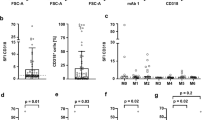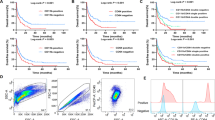Abstract
Aberrant expression of the interleukin-3 receptor alpha chain (IL3RA or CD123) is frequently observed in patients with a subset of leukemic disorders, including acute myeloid leukemia (AML), particularly in leukemia stem cells. We analyzed the relationships between immunohistochemical (IHC) expression, including that of CD123, and clinical outcomes. This study involved a retrospective analysis of 48 patients diagnosed with de novo AML (M0–M5, n = 48) at our hospital between February 2008 and September 2015. Among patients with de novo AML, CD123 expression was associated with a failure to achieve complete response (CR) to initial induction chemotherapy (P = 0.044) and poor overall survival (OS) (P = 0.036). This is the first study using IHC to demonstrate that CD123 expression is associated with a poor CR rate and poor OS in de novo AML patients. These results support previous reports using flow cytometry (FCM). CD123 expression may thus be useful for assessing AML patients’ prognoses. At the time of diagnosis, CD123 expression analysis using IHC may represent a clinically useful assessment for de novo AML patients.


Similar content being viewed by others
References
Testa U, Riccioni R, Diverio D, Rossini A, Lo Coco F, Peschle C. Interleukin-3 receptor in acute leukemia. Leukemia. 2004;18:219–26.
Testa U, Pelosi E, Frankel A. CD 123 is a membrane biomarker and a therapeutic target in hematologic malignancies. Biomark Res. 2014;2:4.
Muñoz L, Nomdedéu JF, López O, Carnicer MJ, Bellido M, Aventín A, et al. Interleukin-3 receptor α chain (CD123) is widely expressed in hematologic malignancies. Haematologica. 2001;86:1261–9.
Ihle JN. Interleukin-3 and hematopoiesis. Chem Immunol. 1992;51:65–106.
Blalock WL, Weinstein-Oppenheimer C, Chang F, Hoyle PE, Wang XY, Algate PA, et al. Signal transduction, cell cycle regulatory, and anti-apoptotic pathways regulated by IL-3 in hematopoietic cells: possible sites for intervention with anti-neoplastic drugs. Leukemia Aug. 1999;13:1109–66.
Testa U, Riccioni R, Militi S, Coccia E, Stellacci E, Samoggia P, et al. Elevated expression of IL-3Ralpha in acute myelogenous leukemia is associated with enhanced blast proliferation, increased cellularity, and poor prognosis. Blood. 2002;100:2980–8.
Rollins-Raval M, Pillai R, Warita K, Mitsuhashi-Warita T, Mehta R, Boyiadzis M, et al. CD123 immunohistochemical expression in acute myeloid leukemia is associated with underlying FLT3-ITD and NPM1 mutations. Appl Immunohistochem Mol Morphol. 2003;21:212–7.
Fernandez-Pol S, Ma L, Ohgami RS, Arber DA. Immunohistochemistry for p53 is a useful tool to identify cases of acute myeloid leukemia with myelodysplasia-related changes that are TP53 mutated, have complex karyotype, and have poor prognosis. Mod Pathol. 2017;30:382–92.
Hou HA, Chou WC, Kuo YY, Liu CY, Lin LI, Tseng MH, et al. TP53 mutations in de novo acute myeloid leukemia patients: longitudinal follow-ups show the mutation is stable during disease evolution. Blood Cancer J. 2015;5:e331.
Orazi A, Cattoretti G, Heerema NA, Sozzi G, John K, Neiman RS. Frequent p53 overexpression in therapy related myelodysplastic syndromes and acute myeloid leukemias: an immunohistochemical study of bone marrow biopsies. Mod Pathol. 1993;6:521–5.
McGraw KL, Nguyen J, Komrokji RS, Sallman D, Al Ali NH, Padron E, et al. Immunohistochemical pattern of p53 is a measure of TP53 mutation burden and adverse clinical outcome in myelodysplastic syndromes and secondary acute myeloid leukemia. Haematologica. 2016;101:e320.
Vergez F, Green AS, Tamburini J, Sarry JE, Gaillard B, Cornillet-Lefebvre P, et al. High levels of CD34 + CD38 low/-CD123 + blasts are predictive of an adverse outcome in acute myeloid leukemia: a groupeouest-est des leucémiesaiguës et maladies du sang (GOELAMS) study. Haematologica. 2011;96:1792–8.
Robert CB Jr, Daniel PR, Susan FH, Herbert B, John F Jr MJ, et al. 2000 update of recommendations for the use of tumor markers in breast and colorectal cancer: clinical practice guidelines of the American Society of Clinical Oncology. J Clin Oncol. 2001;19(6):1865–78.
Hattori N, Fukuchi K, Nakamaki T, Homma M, Ariizumi H, Nakashima H, et al. P53 protein expression in chronic myelomonocytic leukemia-1 correlates with progression to leukemia and a poor prognosis. Acta Haematol. 2011;125:242–6.
Iwasaki T, Murakami M, Sugisaki C, Sobue S, Ohashi H, Asano H, et al. Characterization of myelodysplastic syndrome and aplastic anemia by immunostaining of p53 and hemoglobin F and karyotype analysis: differential diagnosis between refractory anemia and aplastic anemia. Pathol Int. 2008;58:353–60.
Al-Mawali A, Gillis D, Lewis I. Immunoprofiling of leukemic stem cells CD34+/CD38–/CD123 + delineate FLT3/ITD-positive clones. J Hematol Oncol. 2016;9:61.
Ehninger A, Kramer M, Röllig C, Thiede C, Bornhäuser M, von Bonin M,et al. Distribution and levels of cell surface expression of CD33 and CD123 in acute myeloid leukemia. Blood Cancer J. 2014;4:e218.
Döhner H, Estey EH, Amadori S, Appelbaum FR, Büchner T, Burnett AK, et al. Diagnosis and management of acute myeloid leukemia in adults: recommendations from an international expert panel, on behalf of the European LeukemiaNet. Blood. 2010;115:453–74.
Stein C, Kellner C, Kügler M, Reiff N, Mentz K, Schwenkert M, et al. Novel conjugates of single-chain Fv antibody fragments specific for stem cell antigen CD123 mediate potent death of acute myeloid leukaemia cells: research paper. Br J Haematol. 2010;148:879–89.
Majeti R. Monoclonal antibody therapy directed against human acute myeloid leukemia stem cells. Oncogene. 2011;30:1009–19.
Hanekamp D, Closs J, Schuurhuis GJ. Leukemia stem cells; identification and clinical application. Int J Hematol. 2017;105:549–57.
Al-Hussaini M, Rettig MP, Ritchey JK, Karpova D, Uy GL, Eissenberg LG, et al. Targeting CD123 in acute myeloid leukemia using a T-cell—directed dual-affinity retargeting platform. Blood. 2016;127:122–32.
Li G, Li X, Wu H, Yang X, Zhang Y, Chen L, et al. CD123 targeting oncolytic adenoviruses suppress acute myeloid leukemia cell proliferation in vitro and in vivo. Blood Cancer J. 2014;4:194.
Tettamanti S, Marin V, Pizzitola I, Magnani CF, Giordano Attianese GM, et al. Targeting of acute myeloid leukaemia by cytokine-induced killer cells redirected with a novel CD123-specific chimeric antigen receptor. Br J Haematol. 2013;161:389–401.
Pizzitola I, Anjos-Afonso F, Rouault-Pierre K, Lassailly F, Tettamanti S, Spinelli O, et al. Chimeric antigen receptors against CD33/CD123 antigens efficiently target primary acute myeloid leukemia cells in vivo. Leukemia. 2014;28:1596–605.
Moradi-Kalbolandi S, Habibi-Anbouhi M, Golkar M, Behdani M, Rezaei G, Ghazizadeh L, et al. Development of a novel engineered antibody targeting human CD123. Anal Biochem. 2016;511:27–30.
Mardiros A, Dos Santos C, McDonald T, Brown CE, Wang X, Budde LE, et al. T cells expressing CD123-specific chimeric antigen receptors exhibit specific cytolytic effector functions and antitumor effects against human acute myeloid leukemia. Blood. 2013;122:3138–48.
Jin L, Lee EM, Ramshaw HS, Busfield SJ, Peoppl AG, Wilkinson L, et al. Monoclonal antibody-mediated targeting of CD123, IL-3 receptor alpha chain, eliminates human acute myeloid leukemic stem cells. Cell Stem Cell. 2009;1:31–42.
Frankel AE, Woo JH, Ahn C, Pemmaraju N, Medeiros BC, Carraway HE, et al. Activity of SL-401, a targeted therapy directed to interleukin-3 receptor, in blastic plasmacytoid dendritic cell neoplasm patients. Blood. 2014;124:385–92.
Acknowledgements
We wish to thank all physicians, nurses, pharmacists, and support personnel for their care of patients in this study.
Author information
Authors and Affiliations
Corresponding author
Additional information
Publisher’s Note
Springer Nature remains neutral with regard to jurisdictional claims in published maps and institutional affiliations.
About this article
Cite this article
Arai, N., Homma, M., Abe, M. et al. Impact of CD123 expression, analyzed by immunohistochemistry, on clinical outcomes in patients with acute myeloid leukemia. Int J Hematol 109, 539–544 (2019). https://doi.org/10.1007/s12185-019-02616-y
Received:
Revised:
Accepted:
Published:
Issue Date:
DOI: https://doi.org/10.1007/s12185-019-02616-y




